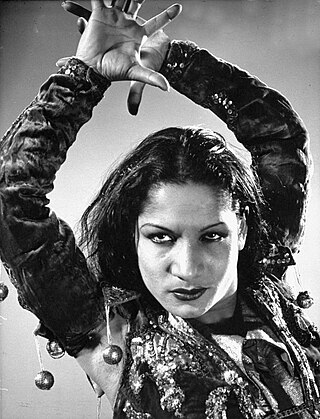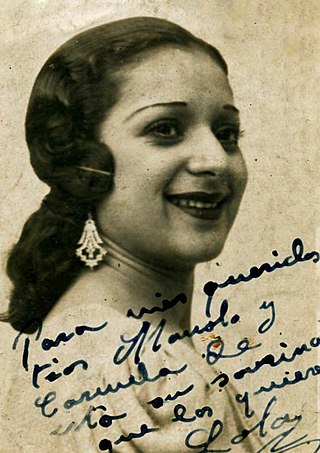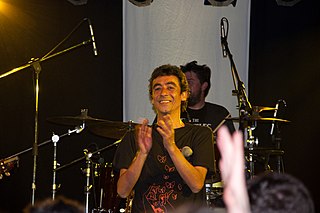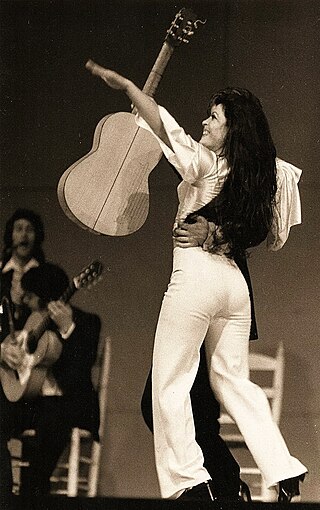
Flamenco is an art form based on the various folkloric music traditions of southern Spain, developed within the gitano subculture of the region of Andalusia, and also having historical presence in Extremadura and Murcia. In a wider sense, the term is used to refer to a variety of both contemporary and traditional musical styles typical of southern Spain. Flamenco is closely associated to the gitanos of the Romani ethnicity who have contributed significantly to its origination and professionalization. However, its style is uniquely Andalusian and flamenco artists have historically included Spaniards of both gitano and non-gitano heritage.

Carmen Amaya was a Spanish Romani flamenco dancer and singer, born in the Somorrostro district of Barcelona, Catalonia, Spain.

Encarnación López Júlvez, better known by her stage name, La Argentinita, was a Spanish-Argentine flamenco dancer, choreographer and singer. La Argentinita was considered one of the highest expressions of this art form during her time.

María Dolores "Lola" Flores Ruiz was a Spanish actress, bailaora and singer. Born in Jerez de la Frontera, Flores became interested in the performing arts at a very young age. Known for her overwhelming personality onstage, she debuted as a dancer at age sixteen at the stage production Luces de España, in her hometown. After being discovered by film director Fernando Mignoni, Flores moved to Madrid to pursue a professional career in music and film, with her first gig being the lead role in Mignoni's Martingala (1940). Flores succeeded as a film and stage actress. In 1943 she obtained her breakthrough role in the musical stage production Zambra alongside Manolo Caracol, in which she sang original compositions by Rafael de León, Manuel López-Quiroga Miquel and Antonio Quintero, including "La Zarzamora" and "La Niña de Fuego", mostly singing flamenco music, copla, rumba and ranchera. She then started to receive widespread media coverage.

María del Rocío Mohedano Jurado, better known as Rocío Jurado, was a Spanish singer and actress. She was born in Chipiona (Cádiz) and nicknamed "La más grande".

Micaela Flores Amaya, better known by her stage name, La Chunga, is a spanish flamenco dancer, and painter of naïf art.
Juana la Macarrona was a Spanish flamenco dancer (bailaora).
The cante flamenco, meaning "flamenco singing", is one of the three main components of flamenco, along with toque and baile (dance). Because the dancer is front and center in a flamenco performance, foreigners often assume the dance is the most important aspect of the art form — in fact, it is the cante which is the heart and soul of the genre. A cante singer is a cantaor or cantaora.

Cristina Hoyos Panadero is a Spanish flamenco dancer, choreographer and actress, born in Seville, Spain. After a successful worldwide career, she opened her own dance company in 1988 that premiered at the Rex Theatre in Paris. She played an important role during the opening and closing ceremonies of the 1992 Summer Olympics in Barcelona.

Carmen Pacheco Rodríguez, better known by her stage name Carmen Linares, is a Spanish flamenco singer.

Eva María Garrido García, known professionally as Eva Yerbabuena, is a Spanish flamenco dancer. She formed her own dance company in 1998 and won Spain's National Dance Award in 2001. She is considered one of flamenco's leading performers.

Tomás Moreno Romero, better known as Tomasito, is a Spanish flamenco dancer, singer and rapper born in Jerez de la Frontera, Spain, in 1969. His music style is a very personal mixture of flamenco, pop, rock, hip hop, funky, and other rhythms. He is the son of Bastiana, also flamencodancer.

María Jesús Pagés Madrigal, better known as María Pagés, is a modern Spanish dancer and choreographer. Considered one of the premiere living Flamenco dancers, Pagés has been recognised internationally for decades as one of the top performers of the style, with her expressive stage presence and passionate, unique rhythmic interpretations. She is among the paramount representatives of flamenco vanguard. Critically and publicly acclaimed for her personal, aesthetic approach to Flamenco performance, Pagés has long-since proven herself to be the current leading pioneer in the modern understanding of this ever-evolving art form. In 1990, she founded a dance company which is now based in Madrid, and has continued performing worldwide ever since. In 2014, she was awarded the government's Gold Medal of Merit in the Fine Arts (Spain) by the Spanish Ministry of Culture.
Silvia Marin is a flamenco dancer, who is best known for her work with her company called El Flamenco vive. She was born in Italy, and was first exposed to flamenco dance when she was 20. This prompted her to move to Spain to study the art, and has since worked on stage, television, film and other projects. She founded El Flamenco Vive in 1997, to promote the dance to children, especially Spanish children. The company has performed at major cultural festivals in Europe and other countries such as the Festival Internacional Cervantino in Mexico. Her work has been recognized with various awards including the Premio Cultural a la Didáctica from the XLVII Festival Internacional del Cante de las Minas and the Onoreflicenza di Cavaliere Dell’ Ordine della Stella della Solidarietá Italiana.
Ana Morales Moreno, known as Ana Morales, is a Spanish flamenco dancer and choreographer, who has established her own dance company.

Antoñita Singla is a Spanish-born Romani flamenco dancer and actress. She often went by the stage name Antoñita La Singla or simply "La Singla".
Rita Giménez García, most commonly known as Rita la Cantaora, was one of the most famous Spanish singers of flamenco in her time due to her performances in cafés cantantes, places where flamenco artists used to play music live.
Josefa Díaz Fernández, popularly known as Pepa de Oro,, was a Spanish flamenco dancer and singer.

La Macanita is the artistic name of Tomasa Guerrero Carrasco, a Spanish flamenco singer.

Pastora Imperio is the artistic name of Pastora Rojas Monje, a dancer from Seville and one of the most representative figures of flamenco folklore of all times. She was the great-grandmother of the Spanish actress Pastora Vega.














